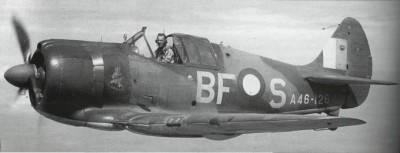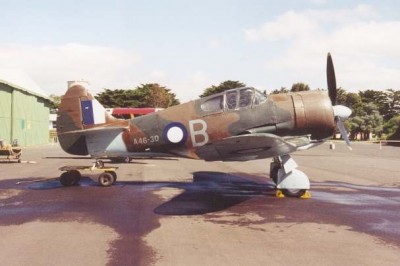| Název: Name: | CAC CA-12 Boomerang | CAC CA-12 Boomerang |
| Originální název: Original Name: | CAC CA-12 Boomerang | |
| Kategorie: Category: | stíhací letoun | fighter aeroplane |
| Výrobce: Producer: | DD.05.1942-DD.08.1943 Commonwealth Aircraft Corporation Pty., Ltd., Fishermen's Bend, Victoria | |
| Období výroby: Production Period: | DD.07.1942-DD.08.1943 | |
| Vyrobeno kusů: Number of Produced: | 5 prototypů 100 sériových (Serial A46-1 to A46-105) | |
| První vzlet: Maiden Flight: | 29.05.1942 | |
| Osádka: Crew: | 1 | |
| Základní charakteristika: Basic Characteristics: | ||
| Vzlet a přistání: Take-off and Landing: | CTOL - konvenční vzlet a přistání | CTOL - conventional take-off and landing |
| Uspořádání křídla: Arrangement of Wing: | jednoplošník | monoplane |
| Uspořádání letounu: Aircraft Concept: | klasické | conventional |
| Podvozek: Undercarriage: | zatahovací | retractable |
| Přistávací zařízení: Landing Gear: | kola | wheels |
| Technické údaje: Technical Data: | ||
| Hmotnost prázdného letounu: Empty Weight: | 2437 kg | 5373 lb |
| Vzletová hmotnost: Take-off Weight: | 3492 kg | 7699 lb |
| Maximální vzletová hmotnost: Maximum Take-off Weight: | 3742 kg | 8249 lb |
| Rozpětí: Wingspan: | 10.970 m | 36ft 0in |
| Délka: Length: | 8.150 m | 26ft 9in |
| Výška: Height: | 3.960 m | 13ft 0in |
| Plocha křídla: Wing Area: | 20.90 m2 | 225,0 ft2 |
| Plošné zatížení: Wing Loading: | 166.98 kg/m2 | 34,20 lb/ft2 |
| Pohon: Propulsion: | ||
| Kategorie: Category: | pístový | piston |
| Počet motorů: Number of Engines: | 1 | |
| Typ: Type: | Pratt & Whitney R-1830-S3C4-G Twin Wasp vzduchem chlazený dvouhvězdicový čtrnáctiválec o vzletovém výkonu 895 kW při 2 700 ot/min, bojový výkon 895 kW v 3 965 m a trvalý max. výkon 820 kW při 2 550 ot./min v 1 890 m. Vrtule trojlistá kovová Hamilton 3T50 s konstantními otáčkami o průměru 3 350 mm, | C.A.C. built Pratt & Whitney R-1830-S3C4-G Twin Wasp fourteen-cylinder air-cooled two-row radial engine, rated at 1,200 hp at 2,700 r.p.m. for take-off, combat rating 1,200 hp at 2,700 r.p.m. at 13,000 ft and maximum rating 1,100 hp at 2,550 r.p.m. at 6,200 ft, driving a three-blade Hamilton 3T50 constant speed metal propeller of the diameter 10ft 11,9in. |
| Objem palivových nádrží: Fuel Tank Capacity: | 318 l v trupové nádrži, 2x 204,5 l ve dvou nádržích v centroplánu a 318 l v přídavné překližkové nádrži pod trupem. Celkem 1 045 l paliva. | One 70 UK gallon fuselage petrol tank and two 45 UK gallon tanks in the wing centre section. One 70 UK gallon plywood drop tank under the fuselage. Total petrol tank capacity: 230 UK |
| Výkony: Performance: | ||
| Maximální rychlost: Maximum Speed: | 490.8 km/h v 4724 m | 305 mph in 15500 ft |
| Cestovní rychlost: Cruise Speed: | 305.8 km/h v 4572 m | 190 mph in 15000 ft |
| Rychlost stoupání: Climb Rate: | 14.9 m/s | 2940 ft/min |
| Čas výstupu na výšku: Time to Climb to: | 4,0 min do 6096 m | 4,0 min to 20000 ft |
| Operační dostup: Service Ceiling: | 10363 m | 34000 ft |
| Dolet: Range: | 1496.7 km | 930 mi |
| Maximální dolet: Maximum Range: | 2575 km | 1600 mi |
| Výzbroj: Armament: | 2x pevný kanón Hispano Mk.II ráže 20 mm po 60 nábojích, 4x pevný kulomet Browning Mk.II ráže 7,7 mm, po 1 000 nábojích, vše v křídlech. Pumový náklad: 4x značkovací dýmovnice o hmotnosti 9 kg pod centroplánem. | Two fixed forward-firing 0.79in Hispano Mk.II cannons, 60 r.p.g. and four fixed forward-firing 0.303in Browning Mk.II machine-guns, 1,000 r.p.g. Bomb loading: for 20lb smoke bombs under the wing centre section. |
| Uživatelské státy: User States: | Australie (RAAF) | Australia (Royal Australian Air Force) |
| Poznámka: Note: | V době, kdy se Australie zapojila do války s Japonskem (12. 1941), nemělo australské letectvo (RAAF) vhodné stíhací letouny, které by mohlo nasadit proti výkonným japonským strojům. Velká Británie prožívala těžkou dobu a sama potřebovala každý stíhací letoun. Australané si museli pomoci sami, konstruktéři Lawrence Wackett a Fred David radikálně přepracovali drak lehkého bombardéru CAC Wirraway a použili motor, který se licenčně stavěl v CAC - Pratt & Whitney R-1830-S3C4-G. Výsledným dílem byl poměrně malý zavalitý letoun, který byl obratný a ovladatelný natolik, že jej bylo možno postavit proti japonským stíhačům, byť by jen v malých výškách. Později byl letoun převeden k přímé podpoře pozemních jednotek a k označování cílů dýmovnicemi, tyto cíle byly následně bombardovány výkonnějšími a modernějšími stroji. | Australia became involved in the Pacific War in Dec 1941, and the Royal Australian Air Force was ill-prepared to face the superior Japanese fighter aircraft. Taking the Pratt & Whitney Twin Wasp engines, the most powerful engines available to Australians at the time (license built by the Commonwealth Aircraft Corporation), Lawrence Wackett and Fred David designed the CA-12 Boomerang aircraft based upon the Wirraway trainer aircraft starting on 21 Dec 1941. Wackett and David designed the CA-12 Boomerang fighters as small fighters that were maneuverable enough to engage faster Japanese fighters in dogfights. They were also designed to carry ample firepower and armor plating. On 2 Feb 1942, the RAAF ordered 105 CA-12 Mark I aircraft before seeing the flight of the prototype, which would not take place until May. The first batch of CA-12 Boomerang fighters were disappointing, however; the heavy armament and armor deprived the fighters of the maneuverability particularly in higher altitudes. The CA-13 variant began production not long after CA-12, but the improvements were not significant. |
| Zdroje: Sources: | René J. Francillon Ph.D., The Commonwealth Boomerang, No. 148., Profile Publications Ltd., Leatherhead, Surrey, England, No ISBN William Green a Gordon Swanborough, The Complete Book of Fighters, Salamander Books Ltd; New Ed edition, rok 2001, ISBN-10: 1-84065-269-1 Andre R. Zbiegniewski and Jacek Nowicki, CAC Boomerang & CAC Wirraway, Wydawnicto Militaria 43, Warszawa, Wydawnicto Militaria, 1997, ISBN 83-86209-57-7. archiv autora | |
CAC CA-12 Boomerang
Commonwealth Aircraft Corporation (CAC) Boomerang
Due to inadequate supply of suitable fighter aircraft, a requirement for indigenous production arose with the RAAF. CAC responded with the Boomerang type. To simplify the ramp-up of production, some elements of the Wirraway trainer were used in the design. The first five aircraft of the CA-12 production block, from the Pratt & Whitney R-1830-S3C4-G twin-star engine and two-stage compressor, had armament consisting of eight 7.7 mm Browning Mk.II machine guns in the wings. For the next 100 units, ordered in February 1942, it was changed to two 20 mm calibre Hispano Mk.II fixed guns and four Browning Mk.II machine guns. The first aircraft of the CA-12 model flew on 29 May 1942, and deliveries of production units began in July that year.
RAAF units using the CAC Boomerang 1942-1945:
2nd Operations Training Unit
4th RAAF Squadron
5th RAAF Squadron
83rd RAAF Squadron
84th RAAF Squadron
85th RAAF Squadron
85th RAAF Squadron
Due to inadequate supply of suitable fighter aircraft, a requirement for indigenous production arose with the RAAF. CAC responded with the Boomerang type. To simplify the ramp-up of production, some elements of the Wirraway trainer were used in the design. The first five aircraft of the CA-12 production block, from the Pratt & Whitney R-1830-S3C4-G twin-star engine and two-stage compressor, had armament consisting of eight 7.7 mm Browning Mk.II machine guns in the wings. For the next 100 units, ordered in February 1942, it was changed to two 20 mm calibre Hispano Mk.II fixed guns and four Browning Mk.II machine guns. The first aircraft of the CA-12 model flew on 29 May 1942, and deliveries of production units began in July that year.
RAAF units using the CAC Boomerang 1942-1945:
2nd Operations Training Unit
4th RAAF Squadron
5th RAAF Squadron
83rd RAAF Squadron
84th RAAF Squadron
85th RAAF Squadron
85th RAAF Squadron
Reklama
...
| Period | - |
| Producer | - |
| Type | - |
| Camouflage | - |
| Country | - |
| Pilot | - |
| Production No. | - |
| Serial No. / Evidence No. | - |
| Tactical Marking / Imatriculation | - |
| Name | - |
| Unit | - |
| Base | - |
| Date (DD.MM.RRRR) | - |
| Author | - |
| Print size / 300 DPI | - |
| Published with authors permit | - |
| Author Website | - |
Commonwealth CA-12 Boomerang (c/n 853) 85 Sqn
| Period | - |
| Producer | - |
| Type | - |
| Camouflage | - |
| Country | - |
| Pilot | - |
| Production No. | - |
| Serial No. / Evidence No. | - |
| Tactical Marking / Imatriculation | - |
| Name | - |
| Unit | - |
| Base | - |
| Date (DD.MM.RRRR) | - |
| Author | - |
| Print size / 300 DPI | - |
| Published with authors permit | - |
| Author Website | - |
Diskuse
Reklama
Join us
We believe that there are people with different interests and experiences who could contribute their knowledge and ideas. If you love military history and have experience in historical research, writing articles, editing text, moderating, creating images, graphics or videos, or simply have a desire to contribute to our unique system, you can join us and help us create content that will be interesting and beneficial to other readers.
Find out more
